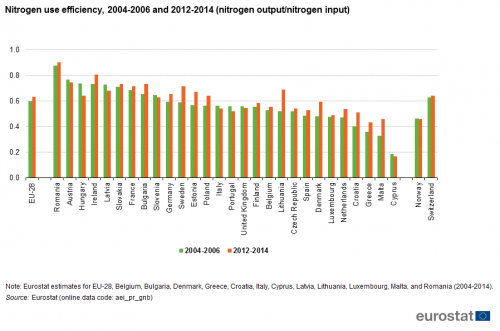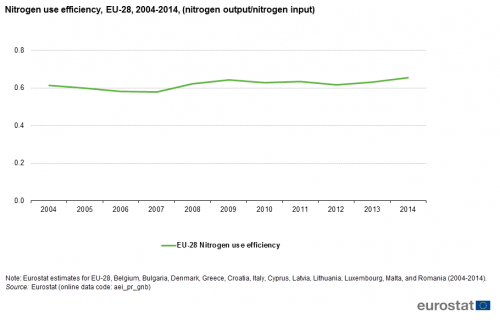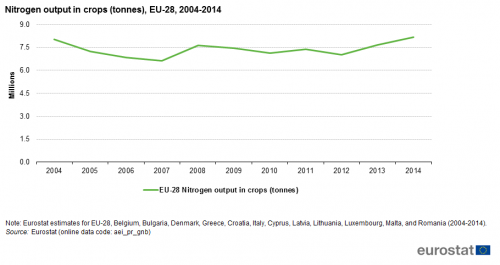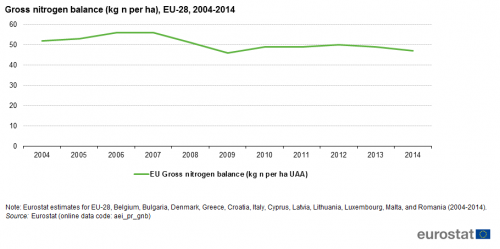Archive:Agri-environmental indicator - gross nitrogen balance
Data from April 2018
Planned update: April 2020
Highlights
The gross nitrogen balance for the EU decreased from 54 kg N per ha per year in the period 2004-2006 to 49 kg N per ha per year in the period 2013-2015
The gross nitrogen balance per hectare of utilised agriculture area for the EU decreased by 10 % from 2004-2015.
People who have a tertiary education and work in a science and technology occupation, 2016
This article provides a fact sheet of the European Union (EU) agri-environmental indicator gross nitrogen balance. It consists of an overview of recent data, complemented by all information on definitions, measurement methods and context needed to interpret them correctly. The gross nitrogen balance article is part of a set of similar fact sheets providing a complete picture of the state of the agri-environmental indicators in the EU.
Full article
Key messages
- The indicator gross nitrogen balance provides an indication of the potential surplus of nitrogen (N) on agricultural land (kg N per ha per year). It also provides trends on nitrogen inputs and outputs on agricultural land over time.
- When calculated as 3-year averages in order to smooth out annual differences in weather or input prices, the gross nitrogen balance (GNB) per ha of utilised agriculture area (UAA) for the EU-28 decreased by 10 % from 2004-2015.
- Decreasing trends in the gross nitrogen balance over the years 2004-2015 were noted in nine EU countries; Denmark, Greece, France, Croatia, Lithuania, Malta, the Netherlands, Sweden and the United Kingdom .
- Increasing trends were shown in four EU countries over the same time period; the Czech Republic, Cyprus, Latvia and Austria .
- Four EU countries had stable trends from 2004-2014; Italy, Poland, Portugal and Slovenia, as well as the EFTA countries Norway and Switzerland .
- No clear trend was visible in the remaining 11 EU countries: Belgium, Bulgaria, Germany, Estonia, Ireland, Spain, Luxembourg, Hungary, Romania, Slovakia, and Finland .
- The quality and accuracy of the estimated GNB per ha depends on the quality and accuracy of underlying data and coefficients used. As methodologies (especially with regards to the coefficients) and data sources used in countries vary, the balances are only consistent within a country across time. The gross nitrogen balances are not consistent across countries, which means that data values should not be compared between countries. Trends can be compared between countries.
- Eurostat facilitates the work to improve the coherence and transparency of data and methodologies used across the countries and to improve the coherence with related data collections such as greenhouse gas inventories by the United Nations Framework Convention on Climate Change (UNFCCC) and the ammonia emissions inventories by the United Nations Economic Commission for Europe (UNECE) - Convention on Long-range Transboundary Air Pollution (CLRTAP). Workshops and projects co-funded by Eurostat are steps in this direction.
Analysis at EU level
The gross nitrogen balance for the EU-28 decreased from an estimated average of 54 kg N per ha per year in the period 2004-2006 to 49 kg N per ha per year in the period 2013-2015 (Figure 1).

Source: Eurostat (aei_pr_gnb)
The inputs of the gross nitrogen balance consist of mineral fertilisers, manure and organic fertilisers, atmospheric deposition, biological nitrogen fixation and seeds and planting material. Mineral fertilisers accounted for 45 % of the N input in the EU in 2014 (country data are not complete for 2015, therefore 2014 values are used for this section). Manure accounted for 38 % of the N input in the same year. The N input from seeds and planting materials is negligible. The re-use of N through the use of compost, sewage sludge, industrial waste etc. is also quite insignificant. Data on other organic fertilisers (except manure) are lacking in many countries and significance of these fertilisers could be underestimated. Data is mostly lacking on manure withdrawals, i.e. manure removed from agriculture and reused elsewhere. Biological nitrogen fixation is on average 6 % of total N input in the EU-28. The level of atmospheric deposition depends on ammonia (NH3) emissions (of which agriculture is the main source), nitrogen oxides (NOx) emissions (where the contribution of agriculture is not significant) and climate conditions (transport through air to other regions). Atmospheric deposition was on average 8 % of total inputs in the EU-28.
Analysis at country level
As explained in the section on Data used and methodology the current balances are not comparable between countries due to differences in definitions, methodologies and data sources used by countries. In this section, some trends at Member State level are highlighted.
Few countries showed an increasing trend in GNB when monitored as 3-year averages from 2004-2015. Only the Czech Republic, Cyprus, Latvia and Austria (Table 1) belonged to this group, and the increases are moderate. A decreasing trend was shown in nine EU countries; Denmark, Greece, France, Croatia, Lithuania, Malta, the Netherlands, Sweden and the United Kingdom, over the same years 2004-2015. For Greece, France, Malta and the Netherlands the decrease stagnated over the years 2010-2015. Four EU countries: Italy, Poland, Portugal and Slovenia, as well as the EFTA countries Norway and Switzerland, had a stable trend from 2004-2015 with no real changes. No clear trend could be identified in the remaining 11 EU countries: Belgium, Bulgaria, Germany, Estonia, Ireland, Spain, Luxembourg, Hungary, Romania, Slovakia, and Finland. Here, the 3-year averages increased or decreased from data point to data point without consistency.
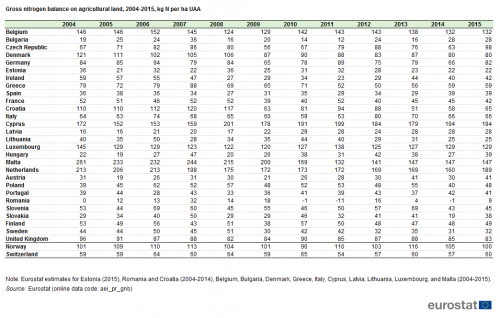
Source: Eurostat (aei_pr_gnb)
Nitrogen use efficiency
Another way of presenting the results of the gross nitrogen balance is the nitrogen use efficiency (NUE) ratio, which is defined as total N outputs divided by total N inputs. It gives an indication of the relative utilisation of nitrogen applied to an agricultural production system. In principle, by decreasing the nitrogen surplus over time, the nutrient use efficiency increases. NUE depends on the production system and its management; it increases as the N output in harvested products increases and/or the N input decreases. Conversely, NUE is low when the N output in harvested products is relatively low and the N input relatively high. Many combinations are possible, but the ideal case would be a high N output via harvested products combined with a high NUE and a low N surplus.
The highest value of NUE does not necessarily mean the best and desirable results. Rates which may be close to or above 1.0 would indicate a risk of soil depletion, as the nutrient uptake by crops exceeds the amount of nutrients applied to the soil. From a longer-term perspective, this trend cannot be considered sustainable.
The development of the NUE indicator is still in progress. For proper interpretation, NUE should be reported together with the N output in harvested products (as indicator for the productivity of the system), and the N surplus (as proxy for the potential N loss to the environment).
Figure 2 shows that the overall NUE in the EU-28 increased only slightly between 2004-2006 and 2012-2014. It could indicate improved utilisation of nutrients applied to the field in a considerable number of Member States. Figure 2 also shows that in most countries the average NUE 2012-2014 had increased compared to the period 2004–2006.
The evolution of NUE as the aggregate for EU-28 between 2004 and 2014 is shown in Figure 3a, and N output in harvested products in Figure 3b. NUE and N output in harvested products have roughly the same development, which is inversed to the GNB over the same time period (Figure 3c). In summary, the trends indicate that while the N losses to the environment are slightly decreasing the productivity is slightly improving in the EU-28, as is the nutrient use efficiency.
The NUE indicator may be useful for presenting how different strategies can contribute towards improving relative utilisation of nutrients applied to agricultural production systems, depending on the initial situation. Depending on context, both intensification and extensification strategies may contribute. In some contexts the main drive may be to increase food production and resource use efficiency, in other contexts the priority may be to protect soil and habitats from degradation.
Source data for tables and graphs
Data sources
Indicator definition
Potential surplus of N on agricultural land (kg N per ha per year).
Links with other indicators
This indicator has links to a number of other AEI indicators that describe developments in some of the main contributory factors.
Data used and methodology
Due to missing data nutrient balances have been estimated by Eurostat for several countries and several years (Table 1). These estimations were based on data available in Eurostat's dissemination database, international public data collections, and published research, and confirmed with the countries in question as reasonable estimates. For 2015, no detailed estimates have been made and therefore no detailed analysis covers this year.
The methodology of the nitrogen balances is described in Eurostat/OECD Nutrient Budgets handbook. The gross nitrogen balance lists all inputs and outputs into and out of the soil and calculates the gross nitrogen surplus as the difference between total inputs and total outputs. The gross nitrogen surplus per ha is derived by dividing the total gross nitrogen surplus by the reference area. The reference area of the current version of balances uploaded in Eurostat database is the UAA. It should be noted that some countries use slightly different methodologies; Austria, the United Kingdom and Spain fall into this group. It means that the time series are comparable within the countries, but the individual values should not be compared with other countries' individual values.
The inputs of the nitrogen balance are:
- Fertilisers, which consist of:
- inorganic fertilisers,
- organic fertilisers (excluding manure).
- Gross manure input, which is calculated from:
- manure production (N excretion; according to the current methodology no reductions are made for N losses due to volatilisation in stables, storages and with the application to the land);
- manure withdrawals (manure export, manure processed as industrial waste, non-agricultural use of manure, other withdrawals);
- change in manure stocks;
- manure import.
- Other nitrogen inputs, which consist of:
- seeds and planting material;
- biological nitrogen fixation by leguminous crops and grass-legume mixtures;
- atmospheric deposition.
The outputs of the gross nitrogen balance are:
- Total removal of N with the harvest of crops (cereals, dried pulses, root crops, industrial crops, vegetables, fruit, ornamental plants, other harvested crops);
- Total removal of N with the harvest and grazing of fodder (permanent grassland and fodder from arable land including temporary grassland);
- Crop residues removed from the field.
The N input and output is estimated for each item of the balance from basic data by multiplying with coefficients to convert the data into N content. Basic data (fertiliser consumption, livestock numbers, crop production, agricultural area) are mostly derived from agricultural statistics. Coefficients are mainly estimated by research institutes and can be based on models, statistical data, measured data as well as expert judgements.
Climatic conditions have a big impact on the balance through the impact on yield and therefore N output. Climate and weather conditions are beyond the control of the farmer. To dampen the effect of weather conditions on the balance the results presented in this fact sheet with regards to the nutrient balance are presented not referring to a particular year but as an average for a certain period. Input prices can have the same distorting effect.
Context
The gross nitrogen balance lists the N inputs to agricultural soils and nitrogen outputs removed from the soil. The main indicator from the gross nitrogen balance is the gross nitrogen surplus (GNS) which is calculated as the difference between total N inputs and total N outputs. The GNS can also be expressed in kg N per ha per year, by dividing the surplus by the reference area. The gross nitrogen balance provides insight into links between agricultural N use and losses of N into environment. A persistent surplus indicates potential environmental problems, such as ammonia (NH3) emissions (contributes to acidification, eutrophication, nitrate leaching (resulting in pollution of drinking water and eutrophication of surface waters) or nitrous oxide emissions (a potent greenhouse gas). A persistent deficit indicates the risk of decline in soil fertility.
Policy relevance
While several human activities influence water quality, agriculture remains a major source of water-related problems. Since gross nutrient balances provide information on the links between agricultural input use, such as nitrogen, loss of nutrients to the environment and the sustainable use of soil nutrient resources, it is one of two main indicators for the EU Common Agriculture Policy's Context indicator 40: water quality.
The 7th Environment Action Programme (EAP) calls for further efforts to manage the nutrient cycle in a more sustainable way and to improve efficiency in the use of fertilisers. Nitrogen balance on agricultural land is used as an annual indicator in support to the monitoring of the 7th EAP.
Eurostat is responsible for the regular monitoring of progress towards the Sustainable Development Goals (SDG) in an EU context. The EU SDG indicator set, developed in cooperation with a large number of stakeholders, comprises 100 indicators and is structured along the 17 SDGs. Gross nitrogen balance is one of the indicators under SDG 2 "Zero Hunger".
Eurostat provides EU-28 data on nitrogen balance to the OECD for use in the OECD indicator set on agri-environment.
Several other policies are indirectly linked to the gross nitrogen balance:
- The Clean Air Programme on the reduction of national emissions of certain atmospheric pollutants. This Directive [1] sets national reduction commitments for the five pollutants (sulphur dioxide, nitrogen oxides, volatile organic compounds, ammonia and fine particulate matter) responsible for acidification, eutrophication and ground-level ozone pollution which leads to significant negative impacts on human health and the environment. It also transposes the reduction commitments for 2020 taken by the EU and its Member States under the revised Gothenburg Protocol and sets more ambitious reduction commitments for 2030 so as to cut the health impacts of air pollution by half compared with 2005.
- The Habitats Directive [2] and the Birds Directive [3]. These Directives aim to ensure biological diversity through the conservation of natural habitats and wild flora and fauna within the European territory. Farmers who have agricultural land in Natura 2000 sites may face restrictions in using their land, such as reduction in the use of fertilisers.
- The Kyoto Protocol is an international agreement linked to the United Nations Framework Convention on Climate Change (UNFCCC). The major feature of the Kyoto Protocol is that it sets binding targets for 37 industrialized countries and the European community for reducing greenhouse gas (GHG) emissions. Reporting is done by the countries through the submission of annual emission inventories and national reports under the Protocol at regular intervals. Items to be reported under the Protocol include the application of mineral nitrogen fertilisers by agriculture, livestock excretion, emission factors etc.
Agri-environmental context
The gross nitrogen balance indicates the total potential risk to the environment (air, water and soil). The output side of the balance presents the nutrient uptake by harvested (and grazed) crops and fodder, and crop residues removed from the field; i.e. the agricultural production from the soil. The input side of the balance counts all N supplied to the soil. Sustainability could be defined by preserving and/or improving the level of production without degrading the natural resources. The harvest and grazing of crops and fodder means that nutrients are removed from the soil. To sustain soil fertility this removal of nutrients should in principle be compensated by supplying the same amount of nutrients. Fertilisers and manure are therefore necessary to supply the crops with N for growing.
However, not all of N in fertilisers and manure reaches the crop. Part of the N is lost due to volatilisation in animal housing, storage and during application to the land. Moreover, organic N in manure first needs to be mineralised before being available to the crop, which means that part of the N may need different amounts of time for being available to plant (depending on soil characteristics and climate conditions – temperature and precipitations). Yield and therefore the uptake of N by crops is not only determined by inputs but also by non-controllable factors like weather. Furthermore, the risk of N leaching and run-off does not only depend on the N excess, but also on the type of soil, precipitation rates, soil saturation, temperature, etc. Abating measures to reduce N emissions directly impact the amount of N in manure and fertilisers applied to the soil. A higher emission rate means lower N content of manure/fertilisers applied to the soil, but means a higher contribution to environmental problems related to GHG and NH3 emissions. Lowering the emission rate means increasing the rate of N in manure/fertilisers, and therefore increasing the potential risk of leaching and run-off.
Therefore, the estimated N surplus by itself does not determine the actual risks to the air, water and soil. The actual risk depends on many factors including climate conditions, soil type and soil characteristics, soil saturation, management practices such as drainage, tillage, irrigation, etc. However, the gross nitrogen balance indicator presents a link between the agricultural activities and the environmental impact and identifies the factors which determine the N surplus and shows the change over time.
Direct access to
<publications>
- Agriculture, forestry and fishery statistics - 2016 edition
</publications
- Gross Nutrient Balance (aei_pr_gnb)
- Gross nutrient balance on agricultural land by nutrient (sdg_02_50)
- Eurostat/OECD Nitrogen Budgets handbook
- Gross nutrient balance (aei_pr_gnb_esms)
- ESS agreement on data collection
- Commission Communication COM(2006)508 final - Development of agri-environmental indicators for monitoring the integration of environmental concerns into the common agricultural policy
- Agri-Environmental Indicators, see:
- European Commission - Agriculture and Rural Development
- European Commission – Environment
- European Commission – Climate Action
Notes
- ↑ Directive (EU) 2016/2284 on the reduction of national emissions of certain atmospheric pollutants
- ↑ Council Directive 92/43/EEC on the conservation of natural habitats and of wild fauna and flora
- ↑ Directive 2009/147/EC on the conservation of wild birds
- ↑ Mark A. Sutton, et al (eds). Nitrogen in Europe - The European Nitrogen Assessment, Cambridge, 2011
- ↑ Sutton M.A. et al. Our Nutrient World. The challenge to produce more food, energy with less pollution. Key Messages for Rio+20. Centre for Ecology; Hydrology, 2012.
- ↑ Mark A. Sutton, Oene Oenema, Jan Willem Erisman, Adrian Leip, Hans van Grinsven; Wilfried Winiwarter. Too much of a good thing. Nature, Volume: 472, Pages: 159–161, 2011
